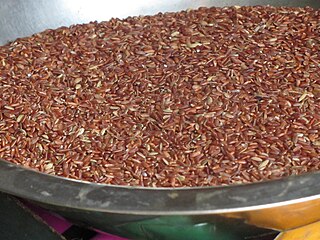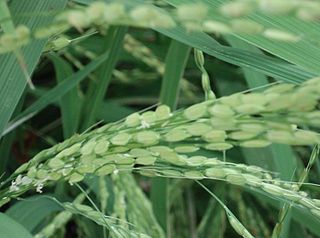
Rice is a cereal grain, and in its domesticated form is the staple food for over half of the world's human population, particularly in Asia and Africa. Rice is the seed of the grass species Oryza sativa or, much less commonly, O. glaberrima. Asian rice was domesticated in China some 13,500 to 8,200 years ago, while African rice was domesticated in Africa some 3,000 years ago. Rice has become commonplace in many cultures worldwide; in 2021, 787 million tons were produced, placing it fourth after sugarcane, maize, and wheat. Only some 8% of rice is traded internationally. China, India, and Indonesia are the largest consumers of rice. A substantial amount of the rice produced in developing nations is lost after harvest through factors such as poor transport and storage. Rice yields can be reduced by pests including insects, rodents, and birds, as well as by weeds, and by diseases such as rice blast. Traditional polycultures such as rice-duck farming, and modern integrated pest management seek to control damage from pests in a sustainable way.

The International Rice Research Institute (IRRI) is an international agricultural research and training organization with its headquarters in Los Baños, Laguna, in the Philippines, and offices in seventeen countries. IRRI is known for its work in developing rice varieties that contributed to the Green Revolution in the 1960s which preempted the famine in Asia.

Biryani is a mixed rice dish most popular in South Asia. It is made with rice, some type of meat and spices. To cater to vegetarians, in some cases, it is prepared by substituting vegetables for the meat. Sometimes eggs and/or potatoes are added.

The Africa Rice Center (AfricaRice), formerly known as the West Africa Rice Development Association (WARDA), is a pan-African intergovernmental association and a CGIAR Research organization, currently headquartered in Abidjan, Côte d'Ivoire. AfricaRice is an agricultural research center that was constituted in 1971 by 11 West African countries. By 2023, the center counted 28 African member states. Since 1986, AfricaRice has been one of the 15 specialized research centers of CGIAR.

The economy of Kerala is the 9th largest in India, with an annual gross state product (GSP) of ₹9.78 lakh crore in 2020–2021. Per-capita GSP of Kerala during the same period is ₹257,711 (US$3,200), the sixth largest in India. In 2019–20, the tertiary sector contributed around 63% of the state's GSVA, compared to 28% by secondary sector, and 8% by primary sector.

Red rice is a variety of rice that is colored red by its anthocyanin content. It is usually eaten unpolished or partially polished, and has a red bran layer, rather than the more common pale brown. Red rice has a nutty flavor. It has the highest nutritional value among rices eaten with the bran intact..

Calrose is a medium grain rice variety, notable for being the founding variety of the California rice industry.
Mankombu or Moncombu is a village in the district of Alappuzha in the state of Kerala, India. Monkombu, part of the Kuttanad delta region popularly mentioned as 'Rice bowl of Kerala'; is one of the major paddy cultivation regions of the state. Its unique geography embodied by Vembanad lake, inter-linked Pambaa, Manimala and Achenkovil river systems, gives rise to islands, back waters, network of waterways and canals, below sea-level paddy fields and marsh. The farmers here have met the challenges of below sea-level cultivation over two centuries. Annual festivals, auspicious rites and religious events at Mankombu Bhagavathi Devi temple, St.Pius church and Pope John Paul Church are occasions for social communion, rejoicing and celebration. Once a prosperous hamlet of hundreds of households, Mankombu today is ravaged by climate change, pollution and dwindling population.

Ezhome is a census town in Kannur district in the Indian state of Kerala.
Panniyoor is a village in Kannur district in the Indian state of Kerala.

Ambalavayal is a village in Wayanad district in the state of Kerala, India. The Wayanad Heritage Museum is located in the village.

Pokkali is a unique saline tolerant rice variety that is cultivated using extensive aquaculture in an organic way in the water-logged coastal regions, spread in about 5000 hectares area in Alappuzha, Thrissur and Ernakulam districts of Kerala in Southern India. The brand Pokkali has received a GI tag from the Geographical Indications Registry Office, Chennai.

Ezhome Rice varieties Ezhome-1 and Ezhome–2 are the first high yielding, non-lodging organic red rice varieties. They are designed for the saline-prone Kaipad rice fields of Kerala. They yield awn-less, non-shattering grains, and favourable cooking qualities, better than local cultivars. The average yields of ‘Ezhome-1’ and ‘Ezhome-2’ are 3.5 tonnes/ha and 3.2 tonnes/ha respectively under close-planted and no-management conditions of Kaipad. This yield is 70% and 60% more than that of local cultivars. These varieties differ in duration, have distinct morphological and qualitative traits, and have different salinity tolerance mechanisms, imparting varietal diversity to the unique ecosystem of Kaipad.

The Thalassery cuisine refers to the distinct cuisine from Thalassery town of northern Kerala, which has blended in Arabian, Persian, Indian and European styles of cooking as a result of its long history as a maritime trading post.
Regional Agricultural Research Station, Pattambi is a research Station under the Central Zone of Kerala Agricultural University at Pattambi in Palakkad district of Kerala, India.
Agricultural Research Station, Mannuthy is a research Station under the Central Zone of Kerala Agricultural University at Mannuthy in Thrissur districts of Kerala, India. This station was established in 1957 as Rice Research Station. Later in 1972 after the formation of Kerala Agricultural University the Rice Research Station along with the Agricultural Research Station brought under the control of KAU. The rice research station and agricultural research stations were merged in 1976 and renamed as Agricultural Research Station, Mannuthy.

The ICAR - Central Tuber Crops Research Institute, often abbreviated as ICAR - CTCRI, is a constituent institute under the Indian Council of Agricultural Research (ICAR) is the only research organization in the world dedicated solely to the research on tropical tuber crops. The Institute established in 1963 with its headquarters at Thiruvananthapuram, Kerala has with an area of 48.19 hectares. The headquarters of ICAR - CTCRI is located at Sreekaryam at a distance 12 km away from Thiruvananthapuram International Airport and 10 km from Thiruvananthapuram Central railway station as well as Central Bus Station Thiruvananthapuram. The Institute has a regional centre at Bhubaneswar, Orissa established in 1976 with an area of 20 hectares located 8 km from Bhubaneswar Airport and 7 km from Bhubaneswar railway station to cater the needs of Eastern India.

The Indian Institute of Spices Research (IISR) is an autonomous organization engaged in agricultural research related to spices in India. The institute has its headquarters in Moozhikkal, Silver Hills, Kozhikode, Kerala and is a subsidiary of Indian Council of Agricultural Research (ICAR), New Delhi, under the Ministry of Agriculture, India.
Krishnaswamy Ramiah was an Indian agricultural scientist, geneticist, parliamentarian and the founder director of Central Rice Research Institute, Cuttack, credited with introducing systematic hybridisation programmes in rice breeding in India. The Government of India honoured him in 1957, with the award of Padma Shri, the fourth-highest Indian civilian award for his services to the nation and followed it up with the third-highest civilian honour of the Padma Bhushan in 1970.

Gandhakasala rice is a variety of rice cultivated by the farmers in Wayanad District in Kerala. This is a scented variety of rice grown mostly by the members of the tribal communities of in Panamaram, Sultan Bathery, and Mananthavady areas in Wayanad. As of 2010, gandhkasala is cultivated in an area of 327 hectares and jeerakasala in 22 hectares.














